南师大 gis 精品课程
南京师范大学GIS各章考核知识点总结+GIS名词解释+南京师范大学GIS历年考研题(名词解释)答案
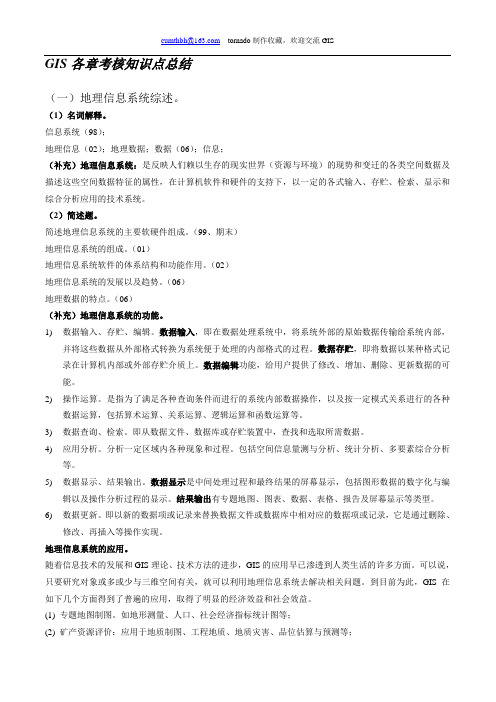
GIS各章考核知识点总结(一)地理信息系统综述。
(1)名词解释。
信息系统(98);地理信息(02);地理数据;数据(06);信息;(补充)地理信息系统:是反映人们赖以生存的现实世界(资源与环境)的现势和变迁的各类空间数据及描述这些空间数据特征的属性,在计算机软件和硬件的支持下,以一定的各式输入、存贮、检索、显示和综合分析应用的技术系统。
(2)简述题。
简述地理信息系统的主要软硬件组成。
(99、期末)地理信息系统的组成。
(01)地理信息系统软件的体系结构和功能作用。
(02)地理信息系统的发展以及趋势。
(06)地理数据的特点。
(06)(补充)地理信息系统的功能。
1)数据输入、存贮、编辑。
数据输入,即在数据处理系统中,将系统外部的原始数据传输给系统内部,并将这些数据从外部格式转换为系统便于处理的内部格式的过程。
数据存贮,即将数据以某种格式记录在计算机内部或外部存贮介质上。
数据编辑功能,给用户提供了修改、增加、删除、更新数据的可能。
2)操作运算。
是指为了满足各种查询条件而进行的系统内部数据操作,以及按一定模式关系进行的各种数据运算,包括算术运算、关系运算、逻辑运算和函数运算等。
3)数据查询、检索。
即从数据文件、数据库或存贮装置中,查找和选取所需数据。
4)应用分析。
分析一定区域内各种现象和过程。
包括空间信息量测与分析、统计分析、多要素综合分析等。
5)数据显示、结果输出。
数据显示是中间处理过程和最终结果的屏幕显示,包括图形数据的数字化与编辑以及操作分析过程的显示。
结果输出有专题地图、图表、数据、表格、报告及屏幕显示等类型。
6)数据更新。
即以新的数据项或记录来替换数据文件或数据库中相对应的数据项或记录,它是通过删除、修改、再插入等操作实现。
地理信息系统的应用。
随着信息技术的发展和GIS理论、技术方法的进步,GIS的应用早已渗透到人类生活的许多方面。
可以说,只要研究对象或多或少与三维空间有关,就可以利用地理信息系统去解决相关问题。
基于精品化战略的地理信息系统专业课程与教材一体化建设

基于精品化战略的地理信息系统专业课程与教材一体化建设摘要:本文总结了南京师范大学地理信息系统专业在课程与教材一体化建设中的经验。
提出教学改革是一项系统工程,必须有效运用系统工程的设计思想与方法,充分把握一体化的实施原则,总体设计、从核心环节突破、以点带面推进、有效实施辐射。
课程与教材建设须坚持“一体化设计、一体化建设、一体化应用、一体化推广”的思路与方法,达到教改的目标。
关键词:地理信息系统;课程;教材;一体化地理信息系统是近20年来快速发展起来的新兴边缘学科。
随着GIS技术在国民经济及国防建设等各方面发挥越来越重要的作用,我国GIS高等教育也得到快速发展。
全国开设本科GIS专业的高等院校,至2007年已超过160个,成为我国发展最快的本科专业之一。
但是,由于新专业发展中的共性以及GIS学科的个性特点,存在的问题较为突出。
集中体现在:课程设置体系相对紊乱;专业教材大多集中在原理类,而技术、方法、实验及应用类教材缺乏,分布很不均衡;课程开设质量较差:专业教育环节矛盾众多,包括各门课程教学内容之间的矛盾,课程与教材的矛盾,理论教学与实践教学的矛盾,教学目标与教学方法的矛盾等,这些都在很大程度上制约了GIS专业本科教学质量的提高。
南京师范大学地理信息系统学科,从2003年起,在江苏省重点教改项目的支持下,开始了地理信息系统专业课程与系列教材建设。
在教学改革和教改项目实施中,运用系统工程的方法,坚持“一体化设计、一体化建设、一体化应用、一体化推广”的思路与方法,取得了预期的教改成果。
主要经验包括以下几个方面。
一、精品化的教改理念近年来,学术界的浮躁风气在部分教学环节上已经出现,课件的华而不实、教材的粗制滥造、讲学的照本宣科、实践的不求深入,在一定程度上影响了教学质量的提高。
我们在本教改项目中将“树立精品意识、组织精品队伍、创造精品成果”,作为教改工作基本理念与实施战略,贯穿到教改工作的每一个环节。
首先,吸纳教学精英,构建教改队伍。
第3章- 第2讲地图投影基本理论汇总
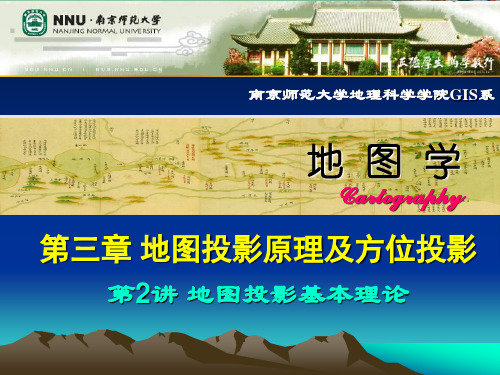
33
(3)等距离投影条件
等距离投影:只在某个特定方向上长度没有变形。 规定经线长度比为1。
m 1
34
等距离投影只在某些特定方向上没有 变形。多用于对投影变形没有特殊要求的 地图,如教学地图。
35
课堂小结
地图投影方程:地图投影的基础 变形:长度、角度、面积
29
(1)等角投影条件
在投影平面上任何一处两方向所夹之 角都无变形, 即最大角度变形为零,长度 比相等。
0
sin a b
2 ab
ab
30
等角投影在微小区域内,图上的图形与实 地是相似的,又叫相似投影或正形投影,其 面积变形比别的投影大。
等角投影在图上量测方向和距离比较方便,世 界各国地形图多用此投影。
dS
dS
ds2 dx2 dy2 dx xBdB xLdL,
x f1B, L y f2B, L
dy y BdB yLdL
ds 2 M 2dB 2 L2dL2
2
EdB2 2FdBdL GdL2 M 2dB 2 L2dL2
tg DC
AD
2 E cos2 F sin 2 G sin 2
13
3、角度变形
u
u
角度变形公式:
角度变形也是一个变量,它随点位的变化而变化。
变形越小越好 局部点、线不变形
14
投影平面切在某点,该点在球面上,也在投影 平面上,这样的点投影后不产生任何变形。
圆锥与地球某纬线圈相切,圆柱在赤道上与地 球相切,这些相切的纬线投影后均无变形。在地 图投影中不变形的纬线称之为标准纬线。
第3章- 第3讲方位投影及其应用
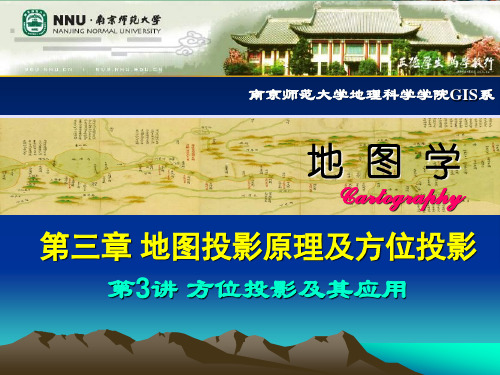
等面积斜方位投影
34
等 面 积 斜 方 位 投 影
35
(3)等距离方位投影
满足等距离投影条件:
1 1
d 1 RdZ
RZ
36
RZ a x cos RZ cos a y sin RZ sin a 1 1
22
23
球面方位投影即是等角方位投影。
球面上任何大小的圆在平面上仍为圆。
24
(3)
正射透视方位投影
Q
Z R
视点位于无穷远
S1
•
•
R sin Z
25
R sin Z a x cos R sin Z cos a y sin R sin Z sin a 1 cos Z 2 1
斜方位投影:
切(割)于极点与赤道之间任一点。
11
方位投影一般公式:
δ
X
ρ
Y
A点地理坐标: ( , )
Q´ A´ Q
A平面极坐标 : ( , )
A点球面坐标:
z aA
P
Z ,
f (Z ) a
12
O
Q'
一般公式:
:等高圈投影半径
:两垂直圈的夹角
Z : 极距
3
3.1 球面坐标系
Q:极点 P
新轴:过Q的直径QQ1
垂直圈:过QQ1的平面与地球 所截大圆(QPQ1) 等高圈:垂直于QQ1的平面与 地球相交所截的圆 球面坐标系: Q为极点,垂直 圈与等高圈两组正交曲线构成。
Q
Q1 P1
4
( 0) 2
南师大gis精品课程(精品课程南师大gis).doc
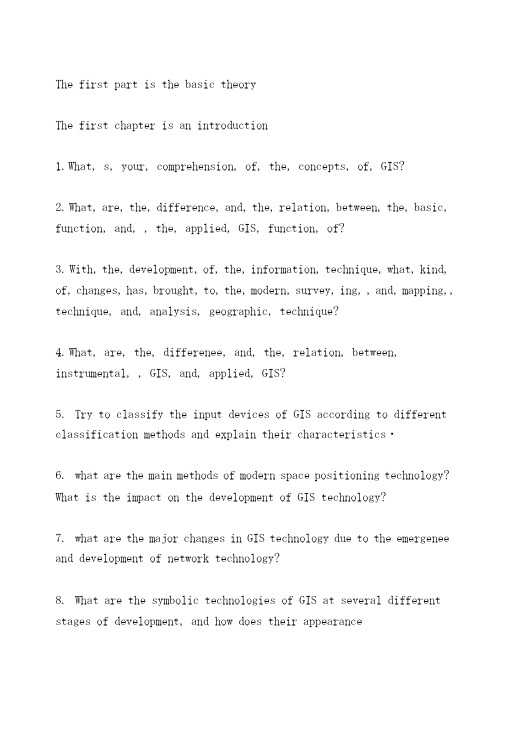
The first part is the basic theoryThe first chapter is an introduction1.W hat, s, your, comprehension, of, the, concepts, of, GIS?2.What, are, the, difference, and, the, relation, between, the, basic, function, and, , the, applied, GIS, function, of?3.With, the, development, of, the, information, technique, what, kind, of, changes, has, brought, to, the, modern, survey, ing, , and, mapping,, technique, and, analysis, geographic, technique?4.What, are, the, differenee, and, the, relation, between, instrumental, , GIS, and, applied, GIS?5.Try to classify the input devices of GIS according to different classification methods and explain their characteristics・6.what are the main methods of modern space positioning technology? What is the impact on the development of GIS technology?7.what are the major changes in GIS technology due to the emergenee and development of network technology?8.What are the symbolic technologies of GIS at several different stages of development, and how does their appearancepromote GIS development?The second chapter is the mathematical basis of Geography1.What, are, the, relations, between, earth, surface, the, the, geoid, and, the, Earth, spherop?2.How, many, coordinate, systems, are, there, describe, the, geographic, spatial, data, to,, What, are, the, them, relations, between?3.What, are, the, advantage, and, the, of, describing, a, point, disadvantage, on, the, ground, by,, using, geodetic,, coordinate, and, geocentric, coordinate?4.What, are, the, main, characteristics, and, the, applicability, of, the, UTM,, Projection, and, Projection, the, Lambert?The 〃How to transform the elevation of the different datunT?6.What are the deformation characteristics of the Gauss projection? Why is it often used as a map projection for large scale ordinary maps?7.in digital maps, what are the changes in meaning and form of map scale?8.Apart from the topographic map, what geographical space frames are there? How do they encode?9.How can GPS data be integrated with digital map data?10,what factors should be considered in choosing the projection? What kind of map projection should I choose if I want to make a land use mapof 1:10?The third chapter is spatial data model1.W hat, are, the, main, characters, of, the, spatial, objects?2.What ' s, the, meaning, of, spatial, relationship, What, s, the, advantage,, of, spatial, relationship, in, objects, describing, the, spatial?3.What are the components of the conceptual model of spatial data? Try to analyze the relationship between them4.try to analyze some of the main data model of GIS, their respective advantages and disadvantages・5.What are the spatial data types? Its characteristics are briefly described・第4章空间数据结构1、比较栅格数据结构和矢量数据结构,它们各自的特点是什么?2、栅格数据和矢量数据结构有交换标准吗?请解释你的观点。
第3讲+++空间数据模型

3.4空间逻辑数据模型
不规则三角网(Triangular Irregular Network,简称TIN)模型
TIN和Voronoi多边形数据模型 图中虚线为Voronoi多边形的边界,实线为TIN边,小圆点代表采样观测点
3.4空间逻辑数据模型
3.4空间逻辑数据模型
面向对象数据模型:面向对象程序设计的应用 应用面向对象方法描述空间实体及其相互关系 ; 面向对象技术的核心是对象(object)和类 (class) ; 一个对象是由描述该对象状态的一组数据和表达 它的行为的一组操作(方法)组成 ; 类是具有部分系统属性和方法的一组对象的集合, 是这些对象的统一抽象描述 类的共性抽象构成超类(super-class),类成为 超类的一个子类,
3.4空间逻辑数据模型
栅格数据模型比较适 宜于用场模型抽象的 的空间对象,采用面 域或空域的枚举来直 接描述空间实体。栅 格可以用数字矩阵来 表示,地理空间坐标 隐含在矩阵的行列上。
栅格数据模型
3.4空间逻辑数据模型
栅格数据模型中,点实体是一个栅格单元 (cell)或像元,线实体由一串彼此相连的 像元构成,面实体则由一系列相邻的像元 构成,像元的大小是一致 ; 栅格和矢量数据模型是最成熟、常用的数 据模型 二者各有优缺点,两种格式互补,满足了 不同的需要
空间认知和抽象过程
空间数据库
计算机世界
物理数据模型 编码、表达、 编码、表达、建立空间关系
数据结构、数据组织
逻辑数据模型 场模型、对象模型、 场模型、对象模型、网络模型
概念世界
概念数据模型
现实世界
综合、 综合、简化和抽象 空间事物和现象
3.2 概念数据模型
概念数据模型:地理空间地理事物与现象 抽象概念集;地理数据的语义解释; 地理空间数据的概念模型包括: 对象模型,网络模型, 场模型
第6讲-GIS进展
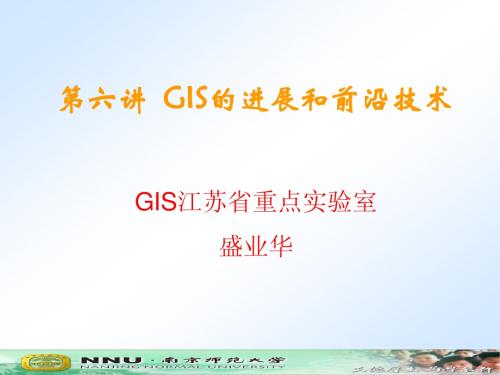
• 针对空间数据库的四维发现状态空间
– 面向空间尺度的操作:是对空间数据由细到粗的计算、 变换、概括、综合的过程。
南京师范大学地理信息科学江苏省重点实验室 盛业华教授
从空间数据库可发现的知识类型
• • • • • • • • 普遍的几何知识 空间分布规律 空间关联规则 空间分类/聚类规则 空间特征规则 空间区分规则 空间演变规则 面向对象的知识
第三代Internet(Internet III)的特点
有线网(波分复用光缆网)和无线网(多颗低轨通 讯卫星覆盖全球)结合; 超高速数据传输; Internet从地球延伸到外层空间;
南京师范大学地理信息科学江苏省重点实验室 盛业华教授
三、空间数据仓库
数据仓库(data ware house)是20世纪90年代发展起来的一 种数据存储、管理和处理方式。从本质上来说是网络数据库 的管理系统及其应用系统。它与普通数据库的区别是:网络 连接的异源、异构、异地、海量的网络数据库,需要具有在 线处理功能,其特点:
Spatial Database 3
南京师范大学地理信息科学江苏省重点实验室
盛业华教授
地理信息系统互操作在不同的情况下具 有不同的侧重点:
– 强调软件功能块之间相互调用时候称为软件 的互操作; – 强调数据集之间的相互透明地访问时候称为 数据的互操作; – 强调信息的共享,在一定语义约束下的互相 操作称为语义的互操作。
盛业华教授
数据、信息和知识
Knowledge
DMKD System
Information
DBMS
DATA
南京师范大学地理信息科学江苏省重点实验室
盛业华教授
空间数据发掘和知识发现的定义和特点
GIS培训课件第一部分

矢量数据是以点、线、面等几何元素为基础,通过坐标表示其位置的 数据结构。
矢量数据空间分析方法
包括缓冲区分析、叠加分析、网络分析等。
缓冲区分析
根据点、线、面等地理要素,自动建立其周围一定宽度范围内的缓冲 区多边形。
叠加分析
将同一地区两个不同地理特征的空间和属性数据重叠相加,以产生空 间区域的多重属性特征,或建立地理对象之间的空间对应关系。
元数据建立
为空间数据建立元数据描述信息,包 括数据来源、质量、处理过程等,以 便于数据共享和使用。
实例分析:空间数据采集与处理过程
案例介绍
以某城市基础地理信息 数据采集与处理为例, 介绍空间数据采集与处
理的全过程。
数据采集
通过野外测量、遥感技 术等方法获取城市基础
地理信息数据。
数据处理
对数据进行编辑、质量 控制、格式转换与标准
GIS作为智慧城市的空间数据基础设施,为各类 智慧应用提供统一的空间数据支撑。
跨部门数据共享与协同
通过GIS平台,实现不同部门间的数据共享和业 务协同,提高政府管理和服务水平。
3
智慧应用创新
基于GIS的空间分析功能,可开发一系列智慧应 用,如智慧交通、智慧环保、智慧安防等,推动 城市可持续发展。
06
推动GIS与其他领域的跨界融合,探索新的应用场景和商业模式 ,为地理信息产业发展带来新的机遇。
THANKS
感谢观看
GIS培训课件第 一部分
汇报人:XX 2024-01-24
目录
• GIS概述与基本原理 • 空间数据采集与处理 • 空间数据库设计与管理 • 空间分析原理与方法 • GIS应用领域与案例分析 • GIS发展趋势与挑战
Arc GIS教程

第5章 空间分析
空间查询
打开美国地图数据States,Rivers,Cities; 单击Selection\Select By Attributes查找“New York” 所在的州;
单击Selection\Select By Location查找纽约州包含的所
有城市;
选中任意一条河流,查询该河流经过的州有哪些?
数据资源管理
文件夹链接
点击File\Connect to Folder选择经常访问 的数据文件夹
目录内容浏览
地图和属性表预览,元数据浏览
创建新文件
Shapefile文件创建并添加字段 新建个人Geodatabase和数据集、要素类 将shapefile和影像文件导入(Import)到 Geodatabase,也可通过Export导出为其它 格式数据 将数据载入(load)至已有要素类,并进行 字段匹配
personalgeodatabasegeodatabase数据arcsdegeodatabasefeaturedatasetfeatureclass2第22章章地图数据管理数据资源管理?文件夹链接点击fileconnecttofolder选择经常访问的数据文件夹?目录内容浏览地图和属性表预览元数据浏览创建新文件?shapefile文件创建并添加字段?新建个人geodatabase和数据集要素类?将shapefile和影像文件导入import到geodatabase也可通过export导出为其它格式数据?将数据载入load至已有要素类并进行字段匹配属性域domain设置?在geodatabase右键菜单databasepropertiesdomain中创建属性域设置其范围域range或代码值域codevalues选择分割和合并策略
GIS课件GIS第一讲(2学时)

4、本课程之特点与要求
(1)信息量丰富(缓冲区、泰森多边形等); (2)知识面宽,知识点多; (3)专业性强(DTM、DEM、DSM); (4)创新要求高(多软件交互操作); (5)应用性特点鲜明(农业行业应用等)。
2021/1/14
5、教学安排
✓ (1)教材选用:邬伦教授编著之书 ✓ (2)讲授内容:1-11章,其他自学 ✓ (3)学时安排:40学时理论教学+32学
2021/1/14
用户界面 系统和数据库管理
数据输入 数据库建立
空间数据处理 空间数据分析
产品生成 产品输出
2021/1/14
甘肃社会经济统计地理信息系统
全省1:5万及主要城市1:1万,最小空间单元到行政 村,10GB
2021/1/14
用GOOGLEEARTH了解地理环境
2021/1/14
中国版Google Earth
2021/1/14
已知最早中国地球仪。于1623年专为当时皇帝(明朝 天启三年)制作
2021/1/14
小贴士:了解地球
地球是一个不规则的椭球体;长半径(a)、短半径(b)、 扁率[α=(a-b)/a]。
埃拉托色尼(公元前276年-公元前194年)计算出地球圆周 长为39690千米,这与现在的测量值40000千米较为接近。
。
2021/1/14
•不透水面层
2021/1/14
文中地理一词则来源于希腊文hê gê(意 为“地球”)和graphein(意为“写”
)。
2021/1/14
地理学
自人系区历应
然 地 理
文 地 理
统 地 理
域 地 理
史 地 理
用 地 理
南京师范大学地理信息系统教程-讲义

专业课复习资料(最新版)
封
面
教学大纲简介
♦课程特点和基本要求
♦教学内容和学时分配
♦考核方式
♦参考书目与主要网站
♦课程特点
▪GIS是一门典型的交叉性学科地理信息系统是多学科、多技术交叉的空间信息系统。
在理论上依托于地理学、测绘学、数学等基础性学科;在技术上取决于计算机软硬件技术、航空航天技术、遥感与雷达技术等的进步;在应用上则依赖于具体应用学科如交通、城市规划、资源管理等理论和技术的发展。
因此,为更好地掌握并深刻理解GIS,有必要理解与GIS相关的学科。
♦课程特点
▪GIS是一门实践性很强的学科
GIS是一门学科,同时又是一个技术系统,即以空间数据为处理对象,以空间数据组织和处理为基础,采用地学模型分析方法,及时提供多种空间地理信息和动态地理信息,为研究环境过程、分析发展趋势、预估规划决策等服务的计算机技术系统。
因此,要重视技能训练,重点掌握ArcInfo等基础GIS软件的操作和使用。
立体化教学模式的GIS国家级精品课程建设

立体化教学模式的GIS国家级精品课程建设
龙毅;汤国安;闾国年
【期刊名称】《测绘通报》
【年(卷),期】2006()12
【摘要】GIS课程是一门集理论、方法、技术与应用于一体的综合性课程,需要学生掌握多个学科的基础知识与应用技能,知识更新快,教学难度大,传统的单一课堂教学方法已不能适应当前GIS课程的需要。
主要探讨南京师范大学GIS国家级精品课程建设的立体化教学模式的基本思路、方法与应用。
【总页数】4页(P69-72)
【关键词】GIS;立体化;教学模式;国家级精品课程
【作者】龙毅;汤国安;闾国年
【作者单位】南京师范大学地理科学学院
【正文语种】中文
【中图分类】P208
【相关文献】
1.高职《社会工作实务》国家级精品课程建设研究——2010年国家级精品课程《社会工作实务》课程建设成果之一 [J], 董海宁;陈宇鹏
2.基于精品课程建设的立体化教学平台构建模式探索 [J], 文盈
3.国家级精品课程《护理学基本技术》立体化教材的建设与体会 [J], 高颖
4.高职高专精品课程建设研究与实践系列之四立体化教材为课程计划的有效实施提
供保障——以高职高专"数据结构"精品课程建设为例 [J], 丁桂芝
5.重视教学效果锤炼精品课程--过程设备设计国家级精品课程建设 [J], 钱才富;段成红;于洪杰;戴凌汉;金广林;蔡纪宁;王奎升;高金吉
因版权原因,仅展示原文概要,查看原文内容请购买。
南师大 gis 精品课程
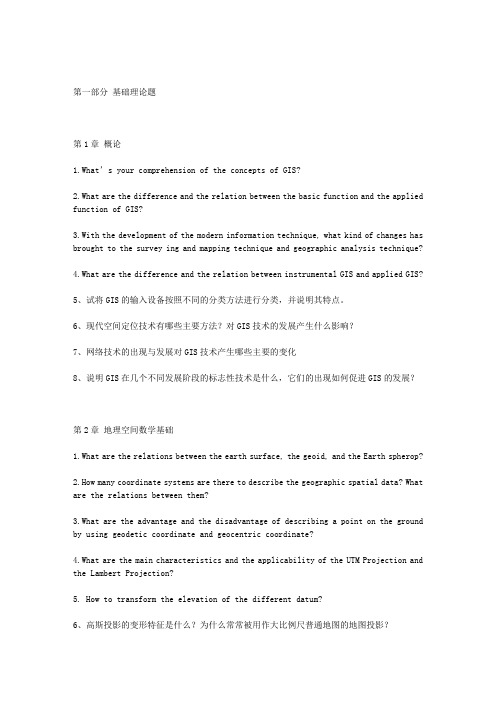
第一部分基础理论题第1章概论1.What’s your comprehension of the concepts of GIS?2.What are the difference and the relation between the basic function and the applied function of GIS?3.With the development of the modern information technique, what kind of changes has brought to the survey ing and mapping technique and geographic analysis technique?4.What are the difference and the relation between instrumental GIS and applied GIS?5、试将GIS的输入设备按照不同的分类方法进行分类,并说明其特点。
6、现代空间定位技术有哪些主要方法?对GIS技术的发展产生什么影响?7、网络技术的出现与发展对GIS技术产生哪些主要的变化8、说明GIS在几个不同发展阶段的标志性技术是什么,它们的出现如何促进GIS的发展?第2章地理空间数学基础1.What are the relations between the earth surface, the geoid, and the Earth spherop?2.How many coordinate systems are there to describe the geographic spatial data? What are the relations between them?3.What are the advantage and the disadvantage of describing a point on the ground by using geodetic coordinate and geocentric coordinate?4.What are the main characteristics and the applicability of the UTM Projection and the Lambert Projection?5. How to transform the elevation of the different datum?6、高斯投影的变形特征是什么?为什么常常被用作大比例尺普通地图的地图投影?7、在数字地图中,地图比例尺在含义与表现形式上有哪些变化?8、除地形分幅外,谈谈还有何种地理空间框架?他们如何进行编码?9、GPS数据如何与地图数字化数据进行集成?10、选择投影需要考虑哪些因素?如果要制作1:10万的土地利用图,该选何种类型的地图投影?第3章空间数据模型1.What are the main characters of the spatial objects?2.What’s the meaning of spatial relationship? What’s the advantage of spatial relationship in describing the spatial objects?3、空间数据的概念模型有哪些组成部分?试分析他们之间的关系?4、试分析GIS的几种主要的数据模型各自的优缺点。
方位投影及其应用

3.3 透视方位投影
3.4 等角、等积、等距方位投影
3
3.1 球面坐标系
Q:极点 P
新轴:过Q的直径QQ1
垂直圈:过QQ1的平面与地球 所截大圆(QPQ1) 等高圈:垂直于QQ1的平面与 地球相交所截的圆 球面坐标系: Q为极点,垂直 圈与等高圈两组正交曲线构成。
Q
Q1 P1
4
( 0) 2
11
方位投影一般公式:
δ
X
ρ
Y
A点地理坐标: ( , )
Q´ A´ Q
A平面极坐标 : ( , )
A点球面坐标:
z aA
P
Z ,
f (Z ) a
12
O
Q'
一般公式:
:等高圈投影半径
:两垂直圈的夹角
Z : 极距
:方位角 1 , 2 :沿垂直圈、等高圈
20
(2)
球面透视方位投影
Q
•
视点位于地球面上
R
R
Z 2 R tan 2
•
Z
Z
S2
21
Z x cos 2 R tan cos a 2 Z y sin 2 R tan sin a 2 2 Z 1 sec 2 2 Z 2 sec 2 4 Z p sec 2 0 Z 2 R tan 2 a
p cos Z Z sin tg 2 2
2等角、等积、等距方位投影
根据不同要求按数学方法探求
方位投影。
27
(1)等角方位投影
按等角投影条件(投影后角度不变形)确定
函数 f ( Z ) 形式。
完整的【ArcGIS地理信息系统空间分析实验教程】(包括光盘数据)

完整的【ArcGIS地理信息系统空间分析实验教程】(包括光盘
数据)
简介:《ArcGIS地理信息系统空间分析实验教程》由南京师范⼤学汤国安教授和杨昕合作编写的。
本书是作者在总结多年教学与研究经验的基础上编写完成的,主要介绍了ArcGIS的使⽤基础、ArcGIS空间分析⼯具及地学分析实例。
具体内容包括:ArcGIS简介、ArcMAP基础操作、数据的创建与编辑、数据的变换、⽮量数据的空间分析、栅格数据的空间分析、空间系统分析、⽔⽂分析以及空间分析建模等。
此外,该书还配有具典型性意义的实例分析及⼤量的随书练习材料,并在光盘中辅以相应数据,以便学⽣课后练习和复习。
本书的主要特点是强调科学性、系统性、实⽤性与易读性的结合,既可作为⾼等院校地理信息系统、地理学、测绘学等相关学科学⽣的教材,也可为科学研究、⼯程设计、规划管理等部门的科技⼈员提供参考。
更多请⾃⼰搜索。
同时发在ESRI中国社区,欢迎前去讨论
2009年1⽉12⽇已更新为固定的下载地址!
下载以下5个⽂件。
其中数据被分卷压缩为3个包,放在同⼀⽬录下解压缩即可。
由于上传的⽹站不⽀持中⽂⽂件夹,导致压缩包名称乱码,下载后请⾃⾏修改。
为⽅便各取所需,分为三部分:
1.ArcGIS地理信息系统空间分析实验教程【第四次更新,内容和以前⼀样,请勿重复下载】
2.实例和练习指导书【第四次更新,内容和以前⼀样,请勿重复下载】
3.实例和练习数据(即光盘数据)【第四次更新,内容和以前⼀样,请勿重复下载】
部分资料预览图⽚
☆欢迎⼤家加⼊GIS 交流QQ群: 10675670(⾼级群)★。
2015年南京师范大学

目标
通过本节课的学习,使学生了解经纬度六十进制的科学依据,掌握解算当地纬度的方法、地磁偏角的相关知识,为后面学习地理数据空间坐标系和空间数据结构等知识做好理论铺垫。
教学重点及处理措施
教学重点:地磁偏角的认识
处理措施:从常规的经纬网相关知识入手,激发学生探究心理,引导学生理解概念,认识到地磁偏角在GIS系统中的重要性,并由易到难的引导学生掌握不同角度地磁偏角的地理范围,注重图形及动画的合理应用,培养学生空间思维能力。
2015年南京师范大学
微课教学设计方案
《地理信息系统》——
“经纬天下-你所不了解的经纬世界”
教学单位:地理科学学院
课程:《地理信息系统》
授课专业:地理信息系统专业
教师姓名:任娜
职称/职务:讲师
教学
对象
地理信息系统系
一年级学生
教学展示内容
经纬天下-你所不了解的经纬世界
课程
类型
必修课
时长
13分钟
知识点分析
以启发式教学方法为主,列举实际生活中的小朋友分蛋糕的实例,激发学生对常规知识和认知探究的兴趣;在进行讲解地磁偏角不同角度范围的时候,通过合理假设,引导学生进行问题的分析和解决。通过启发式引导,使学生理解经纬网中的相关知识的概念及计算方法等。
教学总结
本课程的教学特色在于将多种教学方法相结合以提高学生的学习兴趣和教学质量。在授课过程中,以启发式教学为主,并通过具体的实例将知识点进行融合和巩固,更有助于学生理解和掌握知识点和难点,并注重培养学生独立分析问题和解决问题的能力。
教材信息
1)汤国安,赵牡丹等.《地理信息系统》.科学出版社,2010年版.
2)陈述彭,鲁学军,周成虎.《地理信息系统导论》. 2007年版.
- 1、下载文档前请自行甄别文档内容的完整性,平台不提供额外的编辑、内容补充、找答案等附加服务。
- 2、"仅部分预览"的文档,不可在线预览部分如存在完整性等问题,可反馈申请退款(可完整预览的文档不适用该条件!)。
- 3、如文档侵犯您的权益,请联系客服反馈,我们会尽快为您处理(人工客服工作时间:9:00-18:30)。
第3章 空间数据ห้องสมุดไป่ตู้型
1.What are the main characters of the spatial objects?
2.What’s the meaning of spatial relationship? What’s the advantage of spatial relationship in describing the spatial objects?
12、如何评价GIS的数据质量,以野外测量为例,分析其数据误差的来源。
第7章 空间数据查询与空间度量
1,Describe the types and the contents of the spatial data query briefly.
2.Describe the meaning of topological relationships query in the field of geographic analysis.
2. 说明空间数据查询的一般过程及查询结果的显示方式。
4. 说明分形维数提取方法及其在空间分析中的作用。
第8章 GIS基本空间分析
1,Describe the principle and the usage of buffer analysis, and compare the two ways of building buffer areas which introduced in this chapter.
5.简述基于C/S模式和基于B/S模式的网络GIS各自的原理和特点?什么叫瘦客户端?
pare the ways of resampling the raster data.
5.How many ways are there to do data format conversion?
6.Describe the main contents and ways of editing spatial data briefly.
7、假设一条矢量等高线上的点太过密集了,如何减少占用系统的存储空间?你能给出多少方法?各有什么适用范围?
8、对于扫描仪输出的结果一般需要做哪些处理?
9、如果两个作业小组各自从数字化仪上得到两张相邻图幅的地图数据,在GIS中不能准确对接,该怎么办?
10、空间数据共享的方法有哪些?
11、简述空间数据入库流程。
2.How many coordinate systems are there to describe the geographic spatial data? What are the relations between them?
3.What are the advantage and the disadvantage of describing a point on the ground by using geodetic coordinate and geocentric coordinate?
3、 空间数据的概念模型有哪些组成部分?试分析他们之间的关系?
4、 试分析GIS的几种主要的数据模型各自的优缺点。
5、 空间数据类型有哪些?简述其特征。
第4章 空间数据结构
1、Comparing raster data structure with vector data structure, what are their respective characters?
2.Can we get all the data from the map? Please explain it by using an example.
3.How can users find the mistakes from the data which was inputted into GIS?
3.Describe the concepts, extract method and geographic meanings of slope, aspect, plan curve and profile curve.
4.简述规则格网DEM和TIN的数字地形分析的主要内容,并比较它们的异同。
3.With the development of the modern information technique, what kind of changes has brought to the survey ing and mapping technique and geographic analysis technique?
2. Describe the output products of GIS and tell the character of them.
3.Describe the function and the meaning of map symbols, which used in spatial information visualization.
2.What are the basic demands of spatial data for network analysis?
3. 栅格数据与矢量数据在多层面叠置方法与结果上有什么差异?叠置分析的地学意义是什么?
4. 举例说明不同形状的空间分析窗口在地学分析中的作用。
5. 试分析栅格数据在GIS空间分析中的优点与局限性。
7、网络技术的出现与发展对GIS技术产生哪些主要的变化
8、说明GIS在几个不同发展阶段的标志性技术是什么,它们的出现如何促进GIS的发展?
第2章 地理空间数学基础
1.What are the relations between the earth surface, the geoid, and the Earth spherop?
第9章 DEM与数字地形分析
1. What are the position and the function of DEM in the field of GIS spatial data and analysis?
2.Describe the source of DEM data and tell the character of it briefly.
2.How to explain the variograms?
3.什么叫探索性数据分析?探索性数据分析的目的?
4.空间自相关问题使用什么参数进行分析?其结果的地理解释是什么?
5.什么是空间回归,与经典的回归有什么差异?
第11章 地理信息可视化
1. Describe the concept and the form of spatial information visualization briefly.
4、总结矢量数据和栅格数据在结构表达方面的特色。
5、简述栅格数据压缩编码的几种方式和各自优缺点。
6、简述矢量数据编码的几种方式和各自优缺点。
7、给出一张图,试写出图中的DIME数据文件和对其中多边形进行联接编辑的算法步骤,比较多边形联接编辑的异同。
第5章 空间数据组织与管理
第一部分 基础理论题
第1章 概论
1.What’s your comprehension of the concepts of GIS?
2.What are the difference and the relation between the basic function and the applied function of GIS?
2.Do raster data and vector data structure have their interchange standard? Please explain your point of view.
3.Someone think of the vector data’s innate character is raster data. What’s your opinion of this sentence?
4.What’s visual reality? What’s the meaning and function of the visual reality in spatial information visualization?
5.简述地图图面配置的方法与内容。
6.简述分层设色法的内容和它在地图制图中的应用意义。
3、栅格数据的管理方式有哪些,各有什么优缺点?
4、数据库中空间数据是如何进行分幅分层组织的?
5、空间数据的索引方式有哪些,比较各种方法的优缺点。
第6章 空间数据采集与处理
1、How many kinds of GIS data source are there? Describe their characters and the way of collecting them briefly.
4.What are the main characteristics and the applicability of the UTM Projection and the Lambert Projection?
5. How to transform the elevation of the different datum?
7.在三维可视化方面,比较等值线图、晕渲图和透视立体图的优缺点。
8.空间信息的三维建模有哪些,各自有何特点。
第12章 地理信息的传输
1. What’s the concept of WebGIS? What are the main character and advantage of WebGIS?
1、What’s the meaning and the character of spatial database?
